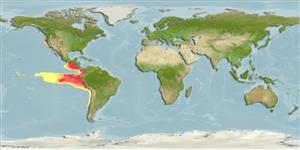>
Lophiiformes (Anglerfishes) >
Oneirodidae (Dreamers)
Etymology: Ctenochirichthys: Greek 'kteis', 'ktenos' = comb + Greek, 'cheiros' = hand (or its evolutionary homolog, the pectoral fin) + Greek, 'ichthys' = fish (Ref. 86949).
More on authors: Regan & Trewavas.
Environment: milieu / climate zone / depth range / distribution range
Écologie
marin bathypélagique; profondeur 800 - 1000 m (Ref. 86949). Deep-water
Pacific Ocean: Chile and Panama.
Taille / Poids / Âge
Maturity: Lm ? range ? - ? cm
Description synthétique
Morphologie | Morphométrie
Rayons mous dorsaux (Total): 6-7; Rayons mous anaux: 4 - 5. Metamorphosed males and females have an extremely long pectoral fin lobe, bearing high number of pectoral fin rays, inserted along dorsal margin and an elongate, slender subopercular bone, tapering only slightly, dorsal end rounded or squared off. Metamorphosed females are further unique in having the following characteristics: presence of vomerine teeth; convex dorsal margin of frontal bones; reduced sphenotic spines; lower jaw with small symphysial spine; hyomandibula with double head; small quadrate and articular spines; deeply notched posterior margin of opercle; elongate and slender subopercle throughout its length, ventral end elongate and rounded; well developed second pharyngobranchial; caudal fin rays without internal pigmentation; illicium longer than length of esca bulb; pterygoiphore of illicium cylindrical throughout its length, emerging on snout from between frontal bones, anterior end exposed, posterior end concealed beneath skin; well developed first ray of dorsal fin; dorsal fin rays 6-7; anal fin rays 4-5; extremely long and narrow pectoral fin lobe, longer than longest rays of pectoral fin; pectoral fin rays 28-30; skin presumably naked, without dermal spinules; darkly pigmented skin of caudal peduncle extends well past base of caudal fin (Ref. 86949). Metamorphosed males: have 13 olfactory lamellae; 9 upper denticular teeth arranged in two rows, inner row with 8 teeth, outer row with 3 teeth; naked skin, without dermal spinules (Ref. 86949). Larvae: elongate body; depth of body and length of the head measures 40-45% of SL; concentration of pigment lies medial to subopercle; dorsal pig mentation restricted to anterodorsal part of body (Ref. 86949).
Life cycle and mating behavior
Maturité | Reproduction | Frai | Œufs | Fécondité | Larves
Pequeño, G., 1989. Peces de Chile. Lista sistematica revisada y comentada. Rev. Biol. Mar., Valparaiso 24(2):1-132. (Ref. 9068)
Statut dans la liste rouge de l'IUCN (Ref. 130435)
Menace pour l'homme
Harmless
Utilisations par l'homme
Plus d'informations
Noms communsSynonymesMétabolismePrédateursÉcotoxicologieReproductionMaturitéFraiRassemblement de ponteFéconditéŒufsDéveloppement de l'œuf
Taille/ÂgeCroissanceLongueur-poidsLongueur-longueurFréquences de longueursMorphométrieMorphologieLarvesDynamique des populations larvairesRecrutementAbondanceBRUVS
RéférencesAquacultureProfil d'aquacultureSouchesGénétiqueElectrophoresesHéritabilitéPathologiesTraitementNutrientsMass conversion
CollaborateursImagesStamps, Coins Misc.SonsCiguateraVitesseType de nageSurface branchialeOtolithesCerveauxVision
Outils
Articles particuliers
Télécharger en XML
Sources Internet
Estimates based on models
Preferred temperature (Ref.
123201): 1.7 - 2.6, mean 1.9 °C (based on 168 cells).
Phylogenetic diversity index (Ref.
82804): PD
50 = 1.0000 [Uniqueness, from 0.5 = low to 2.0 = high].
Bayesian length-weight: a=0.01995 (0.00906 - 0.04395), b=3.01 (2.83 - 3.19), in cm total length, based on all LWR estimates for this body shape (Ref.
93245).
Niveau trophique (Ref.
69278): 3.8 ±0.5 se; based on size and trophs of closest relatives
Résilience (Ref.
120179): Haut, temps minimum de doublement de population inférieur à 15 mois (Preliminary K or Fecundity.).
Fishing Vulnerability (Ref.
59153): Low vulnerability (10 of 100).
